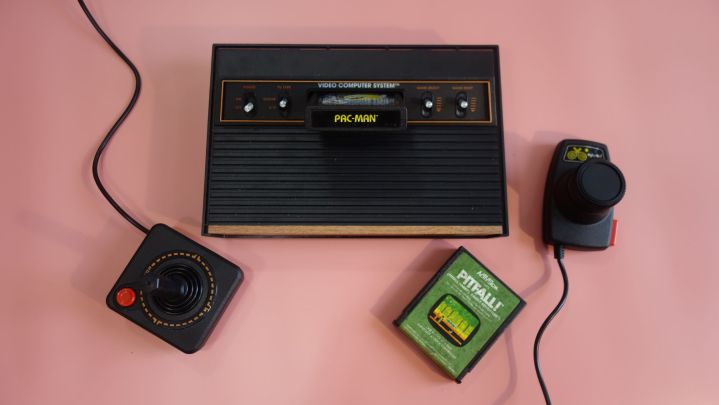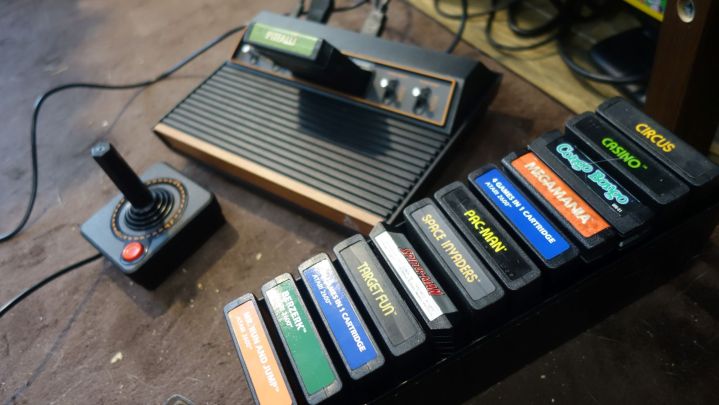
I can still remember every detail of my years spent playing my mom’s hand-me-down Atari 2600 as a kid. I had the system set up on an old CRT TV in the corner of my bedroom. On weekends, I’d sit down on my soft blue carpet and crack open my mom’s dusty old cartridge case. I can feel the sensation of forcing a chunky game into the console’s slot until it clicks into place. I remember what it felt like to run my fingers on top of the console’s textured plastic design or to fight against the resistance in the system’s tight joystick. Sure, I still have strong memories of playing Pac-Man or Space Invaders, but I just as strongly recall the exact distance I was positioned from my screen, sitting in the same cross-legged position.
While companies love to rerelease the games we love, few of them have found ways to preserve the physical act of actually playing those games. Devices like the NES Classic are cute novelties that recreate the look of their old counterparts, but they fall short when it comes to honoring the rituals that formed around the system. Clicking a cartridge into place and blowing on it to try and get it to work is as much a part of Super Mario Bros. as the platforming.
Atari seems to understand that and has worked that idea into its newest retro console: the Atari 2600+. It isn’t just another dime-a-dozen console recreation crafted for easy nostalgia; it’s one of the few devices of its kind to actually capture the feel of the iconic system. That’s a feat that few others can claim — but I hope they follow suit.
Feel the past
The Atari 2600+ is an uncompromising retro system — which is both its most niche aspect and its greatest strength. It’s a nearly 1:1 recreation of the original Atari 2600, except that it can easily hook up to a TV via HDMI and has a button that switches between 4:3 and 16:9 aspect ratios. Otherwise, it’s an incredibly faithful recreation that’s fully functional. It still features levers that change game modes, difficulty, and TV type on the fly. It comes bundled with a gloriously imperfect Atari joystick, and really dedicated fans can even grab a pair of paddles separately. Every single piece I’ve tested looks and feels exactly as I remember.
That’s all commendable, but the 2600+’s best quality is its approach to games. This isn’t another all-in-one game console that just preloads a dozen classics onto the device. Instead, it still features a fully functional cartridge slot that plays both newly released Atari cartridges and any old ones from the 1980s. That makes it a tough sell for anyone who doesn’t have access to old Atari games. The system comes with a 10-in-1 cartridge that contains classics like Missile Command, but it’s otherwise up to players to hunt down games. Frankly, I can’t imagine most people will have old cartridges lying around to make use of the device.
But I do.

Long before I got a Sony PlayStation or Nintendo GameCube, the Atari 2600 would become my first video game console. My mother gave me her old one when I was a kid, complete with paddles, joysticks, and a treasured box of cartridges. Some of those games would go on to become my favorites of all time. I still remember spending months on end picking away at Pitfall. I’d barely even get past its fifth screen in my years with it, but I would come back to it day after day all the same. To this day, I still hold a closer emotional connection to that system than anything I’ve owned since. It connects me to my mother, but it’s also the reason that I love games and why I even get to sit here writing about them like this today.
The moment I heard about the Atari 2600+, I called my mom and asked if our old system was still in storage somewhere. It was, continuing to endure decades later like a cockroach. I had her ship up the old game case, which arrived just a week or so before the new console made its way to me. With both in hand, I instinctively began to set up my living room play space almost exactly as it had been in my old bedroom. I placed the console down on a little rug, neatly placing the game case to its right with the lid off. Rather than sitting on my couch, I got down cross-legged on my floor and placed that same exact Pitfall cartridge — still vibrant green under its fading label — in the slot with a tight click. I flipped the thick, metal power switch and waited for the screen to flicker.

The moment that familiar opening screen popped up on my TV, miraculously running off the same cartridge, my heart fluttered. Years of my childhood came flooding back to me in a wash of green pixels. I could feel my old carpet on my legs, smell the musk coming off the old machine, even hear the faint static of that CRT TV.
For the next few hours, I’d pop in every cartridge I owned to unlock even more of those memories. I’d slot in Spider-Man and instantly remember that I could never figure out how to beat Green Goblin as a kid (I still have not). Pac-Man would gobble up my time as I remembered just how limited the original game was, with its straight lines instead of dots. I’d even make some oddball rediscoveries like Circus, a morbid variant of Breakout that has two trapeze artists launching each other on a seesaw — and splatting dead when they hit the ground.
A transporting artifact
A lot of these old Atari games hold up shockingly well. When I attached a paddle controller and booted up Pong-variant Video Olympics, I found I was just as engaged in the classic duel as I am in a modern multiplayer shooter with all its glitz and glamour. A big part of that comes down to the Atari 2600’s most underrated feature: the physicality of its controls. Spinning a paddle or wrestling with a joystick feels more active and physical than pressing buttons on a gamepad. When I play Breakout, it’s like I’m carefully steering a car. That experience simply can’t be replicated with a standard joystick; you need to feel that spinning circle on your fingertips. The Atari 2600+ offers an easy way to do that, capturing the feel of the era.

Though what ends up captivating me most during my tests is the same game that’s always held my heart: Pitfall. Once I loaded it up, I couldn’t stop playing the old-school side-scroller. It’s as captivating as Uncharted, boiling down the now-bloated action-adventure genre it spawned to its essence. It’s a simple platformer filled with precise challenges and genuine surprises; you never know what will happen on each new screen. Returning to it as an adult meant tackling it with much more skill, which finally let me see what was beyond the first few screens I’d spent hours trying to perfect. I audibly gasped when I reached a screen I’d never found as a kid and discovered a growing and retracting sinkhole. Decades later, one of my favorite games was still finding ways to surprise me.
The Atari 2600+ is the most personal experience I’ve ever had with a piece of gaming tech. Rather than feeling like another holiday season cash grab for retro players, it feels like a true historical artifact recreated with the love and care it deserves. It won’t have the same impact for those who never had the console and just want to play old games (Atari 50: The Anniversary Celebration is better for that), but the games aren’t fully the point. It’s the feeling of brushing your hand over its ridges, the worry that you’re about to snap a cartridge when pushing it into the slot, your body tilting in tandem with the joystick. It’s easy for games to take our brains back to the past, but the Atari 2600+ transports my body back too.
When I turn it on, I am home.
Editors' Recommendations
- Atari celebrates its 50th birthday with a new, working 2600 cartridge
- Plex Arcade brings classic Atari console titles to your TV for $5 per month




